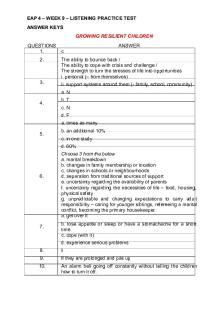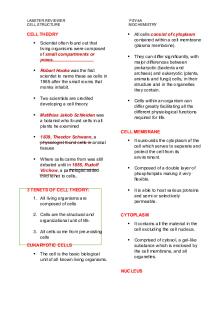Labster Answer keys 1 - Philippine Traditional and Alternative Medicine PDF

| Title | Labster Answer keys 1 - Philippine Traditional and Alternative Medicine |
|---|---|
| Course | preventive medicine |
| Institution | Pontifical and Royal University of Santo Tomas, The Catholic University of the Philippines |
| Pages | 4 |
| File Size | 162.7 KB |
| File Type | |
| Total Downloads | 80 |
| Total Views | 146 |
Summary
Philippine Traditional and Alternative Medicine...
Description
Mitosis 1. All of these options are possible 2. Duplicate existing cells 3. Preservation 4. Identical chromatids 5. Exactly four histones 6. Chromatin Click on 1 7. G1 phase Click on 2 8. S phase Click on 3 9. G2 phase 10. 400x 11. Chromatin 12. Due to uncondensed chromosome 13. 2 14. B 15. D 16. A 17. Specialized cells in gonads 18. 2 for mitosis; 4 for meiosis 19. Haploid Select the uppermost slide 20. Specific Molecules 21. Diploid Select the middle slide 22. Chromosomes 23. Sister chromatids Select the lowermost slide 24. Mitosis phase Click cyclin 25. Both cyclin and cyclin-dependent kinases Click attach chromosome to microtubule 26. M checkpoint 27. 3
28. G2 checkpoint 29. The poison inhibits cell division ELISA 1. To reduce the cost of hemophilia treatment 2. Immunoglobulins Click Direct ELISA 3. Antigens Click Indirect ELISA Click Sandwich ELISA 4. Antibodies Click Competitive ELISA 5. Decrease 6. Indirect Select Amount of Factor IX Select Small molecule Select Anti-FIX antibody 7. Hydrophobic 8. Monoclonal 9. To reduce ELISA background signal 10. Surfactant 11. To achieve valid results 12. To create a standard curve 13. 100 uL 14. 0.7 ng/uL 15. Verify that the negative results are valid 16. Negative Control 17. Increasing the rate of binding Select “Yes! Let’s put the plate in the spectrophotometer” 18. Adding TMB substrate 19. Light protected container 20. Sulfuric Acid 21. Log-log 22. Amount of FIX = (Absorbance + 1.437)/0.9988 23. You have high background 24. Your standard curve is poor
25. Human kidney cell lines CRISPR-Cas applied to TGF-beta induced EMT 1. Formation of the gut epithelium 2. Smad proteins 3. A sample adding just the vehicle which TGF-beta is dissolved in Select “TGF-beta increases E-cadherin expression levels, in particular at sites of cell-cell contact in breast cancer cell lines” Select “TGF-beta promotes the formation of F-actin stress fibers in the cyto skeleton in breast cancer cell lines” 4. It’s a good visual tool for qualitative changes Select “Yes” Select “No, there is no need” Select “No, there is no need” 5. To avoid unspecific antibody-antigen binding 6. Because F-actin is an intracellular protein Piliin niyo yung Secondary Goat Anti Mouse kemerut. Wag yung isa. 7. I neither quenched the fixative nor permeabilized the cells 8. All of them 9. PAM sequence 10. Nuclease 11. Designing a good gRNA sequence Select “No, I think I already know how to design my own targeting sequence. Let’s test my knowledge in the real mission!” Select “TWIST1” Select “gRNA1” 12. Buy a plasmid including both the designed gRNA and the Cas9 sequence 13. Genomic DNA 14. Similar to the one seen before inducing EMT Select “I think it’s ok for today but I would like to see the results after selecting the right gene” Cell Membrane and Transport: Learn how transporters keep cells healthy
1. Other main function of the cell membrane : Controlling the transport of substances 2. Which type of molecule is least able to cross the membrane without transporters?: Ions 3. Which type of molecule is transported by aquaporins: Water 4. Why does active transport require energy: It transports molecules against an electrochemical gradient 5. Which of these options is not a mechanism to control opening and closing of ion channels: ATP binding 6. How does coupled transport allow a molecule to be transported against an EC: A co-transported molecule travels down an EC in either direction 7. Why do we need to label the membrane? To visualize the cell membrane using the fluorescent microscope 8. Cross ? Yes because there is green fluorescence 9. Scorpion toxin : Hyperexcitability: more Na flows into the cell 10. How has adding the protein contributed to healthier cells: The cell membrane is now a selective barrier For the diagram in the lab, in order ? LUNGS ? NERVE ? KIDNEY ? MUSCLE ? HEART PROTEIN SYNTHESIS 1. A- transcrip; B-Translat 2. Which is true: DNA has no hydroxyl group 3. Which image has the circle correct: C 4. 5’-3’: position of carbon atom 5. To which site does tRNA: P 6. Hypothesis lang to 7. Ribosomes, 2 8. Codon
9. Level II biosafety cabinet: the personnel, experiment and environment 10. Base pair interaction with which mRNA: 5’AGU 11. Which type of RNA matches: tRNA, mRNA, rRNA 12. Template strand: bottom 13. 5’- AUU ACA AUG 14. MGVHECP 15. How many nucleotides: 582 16. TGDR 17. Peptide bonds 18. Primary 19. Weak bonds: secondary 20. B and A 21. Difference: 12kDa 22. rhEPO is glycosylated: CHO 23. How many glycosylation: 4 24. Bacteria lack the machinery for making post translational modif 25. E.coli cells do not possess: golgi apparatus 26. Weight percentage of rhEPO: 40% 27. Yes, erythropoietin is best expressed in mammalian cells 28. Mass spec identifies: mass and charge 29. MALDI Is: matrix assisted laser desorption/ionization 30. Macromolecule ionization method: predict the identity of an unknown protein 31. Y, Z then X 32. Function of matrix: ensures ionization of protein molecules 33. Which of these histograms: II, III, IV 34. Which athlete: A 35. EPO can increase energy: red blood cell SPECTRO 1. Measure amount of light that passes through the cuvette 2. Separate light into component wavelengths 3. Light transmitted through the cuvette
Gel electrophoresis 1. Gauge the size of the bands in the sample 2. Near the top because they cannot migrate through the matrix of the gel as fast 3. Labeled dye that binds to the DNA is added 4. Suspect 2 REACTION KINETICS
1. For the Squadrone, we are going to utilize products of the hydrogen peroxide decomposition reaction. What are the products of that reaction? - Oxygen and water 2. What does the Control O2 graph show? - Oxygen concentration increased over time. 3. The reaction rate is the change in concentration of either the reactant or product (X) per unit of time (t). considering the definition, which mathematical formula can we use to express the reaction rate? - Rate = delta (change in)[X]/delta t 4. what can you say about the consumption of hydrogen peroxide compared to the production of oxygen - Rate of consumption of H2O2 = 2 x rate of production of O2 5. what happens if we lower the temperature of the reaction environment? The molecules have a lower kinetic energy 6. what do we call the minimum energy requirement to initiate a chemical reaction? - activation energy 7. after adding a catalyst, what did you notice about the reaction rate? - it increased 8. from experimenting with the solvents which of the statements below are most correct for the reaction rate of our experiment? water as a solvent results in the highest reaction rates
9. can you figure out how having a higher potential energy for the reactant affects the activation energy, all other things being equal? it decreases the activation energy 10. what do you notice when changing the effect of the catalyst? reactions with a catalyst have a lower activation energy 11. let's take a look at arrhenius formula and rate law of hydrogen peroxide decomposition again: k = Ae^Ea/ RT , Rate = k [H2O2] which of the following statements is correct? The lower the activation energy, the faster the reaction rate 12. what can you observe for the energy of the reaction system, when the potential energy of the reactants is greater than that of products? as the reaction proceeds, energy is released SIGNAL TRANSDUCTION 1. Increased number of stained blood vessels (brown) in the ductal carcinoma 2. Mitosis 3. To supply the tumor with oxygen and nutrients 4. Increase in VEGF *look for gel electrophoresis machine* 5. By using a primary antibody targeting VEGF 6. VEGFR runs at a higher molecular weight the VEGF 7. VEGF and VEGFR are overexpressed 8. To check if the same amount of sample was loaded on the gel 9. In the progression of most solid tumors 10. Hydrophobicity 11. All options are correct 12. Second messengers 13. Kinase 14. Tyrosine
15. To test the effect of the inhibitors on activated VEGFR 16. The phosphorylated protein is a different size and will form a distinct band 17. Angomab 18. VEGFR phosphorylation cannot be detected 19. Receptor dimerization is prevented 20. (1st blank)confirm (2nd blank) angomab (3rd blank) phosphorylation (4th blank)ligand binding 21. All options are correct ANTIBODIES 1. Different Rh mom and dad 2. Antibody attack babies rbc 3. Molecules capable of triggering immune response 4. igG 5. 5-fold 6. B cells 7. Hydrogen, vander waals, ionic and hydrophobic 8. Antibodies and empty circle 9. Rhesus antigen 10. Ensures that card is working correctly 11. Antibodies formed a complex with antigens 12. Agglutination can cause blockage in patients blood vessels 13. In order (card 1 to 3): (A-) (B+) (O-) (AB+) 14. Patients 2 and 4 15. No antigen on RBC that can be recognized as foreign 16. Hemolytic disease of newborn 17. In order (carmen to fetus): (A-) (O+) (A+) 18. Yes 19. Typically igM is raised against A and B antigen which can’t cross the placenta...
Similar Free PDFs

Chapter 5 Answer Keys
- 43 Pages

Strategic COST Answer KEYS
- 29 Pages

Answer Keys Activity No
- 6 Pages

Listening Practice - Answer KEYS
- 2 Pages

Ch02 - answer keys
- 65 Pages

1 - Islam and Medicine
- 29 Pages

Prelim Answer KEYS - Lecture notes 1
- 10 Pages

MLA Citation Methods Answer Keys
- 4 Pages

Pupcet reviewer with answer keys
- 13 Pages

Unit 4 Homeostasis Answer Keys
- 53 Pages

Answer KEYS FOR Logistics SEM
- 4 Pages

Bio week 1 labster
- 4 Pages

Labster 1 cell structure
- 10 Pages

Acids and Bases - Labster Lab
- 4 Pages
Popular Institutions
- Tinajero National High School - Annex
- Politeknik Caltex Riau
- Yokohama City University
- SGT University
- University of Al-Qadisiyah
- Divine Word College of Vigan
- Techniek College Rotterdam
- Universidade de Santiago
- Universiti Teknologi MARA Cawangan Johor Kampus Pasir Gudang
- Poltekkes Kemenkes Yogyakarta
- Baguio City National High School
- Colegio san marcos
- preparatoria uno
- Centro de Bachillerato Tecnológico Industrial y de Servicios No. 107
- Dalian Maritime University
- Quang Trung Secondary School
- Colegio Tecnológico en Informática
- Corporación Regional de Educación Superior
- Grupo CEDVA
- Dar Al Uloom University
- Centro de Estudios Preuniversitarios de la Universidad Nacional de Ingeniería
- 上智大学
- Aakash International School, Nuna Majara
- San Felipe Neri Catholic School
- Kang Chiao International School - New Taipei City
- Misamis Occidental National High School
- Institución Educativa Escuela Normal Juan Ladrilleros
- Kolehiyo ng Pantukan
- Batanes State College
- Instituto Continental
- Sekolah Menengah Kejuruan Kesehatan Kaltara (Tarakan)
- Colegio de La Inmaculada Concepcion - Cebu

